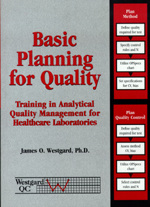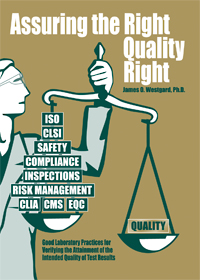Basic Planning for Quality
QP-10: Automated Chemistry Applications
- Quality requirements
- Method imprecision and inaccuracy
- Example applications
- Planning and implementation strategies
- References
Quality planning applications for clinical chemistry tests are perhaps the easiest to get started with because criteria for acceptable performance have been defined by CLIA for many of the routine chemistry tests and estimates of method imprecision and inaccuracy are generally available in the laboratory. It is also helpful that there are documented applications available in the literature. Finally, the high level of automation in chemistry analyzers has improved the performance of chemistry tests, particularly imprecision, thus careful selection of QC procedures can often reduce operating costs! Saving time and money should provide strong motivation for initiating your quality planning applications in the clinical chemistry area.
Quality requirements
CLIA defines criteria for acceptable performance for 27 different tests as part of the proficiency testing guidelines. These criteria are in the form of an allowable total error and are presented as a statement of a target value plus and minus a certain amount. This amount is given in three different forms:
- A percentage, e.g., the acceptable performance for cholesterol is stated as "target value +/- 10%.
- A concentration, e.g., target value +/- 0.5 mmol/L for potassium.
- A interval based on the observed SD of the survey group, e.g., target value +/- 3SD for blood gas pO2. Laboratories can calculate these quality requirements on the basis of group SDs observed in peer review QC programs or previous proficiency testing events.
For some tests, it is necessary to define the medical decision level of interest to interpret the quality requirement, e.g., for glucose, acceptable performance is stated to be target value +/- 6 mg/dL or 10%, whichever is greater.
- At a medical decision level of 50 mg/dL, the quality requirement would be 6 mg/dL or 12%.
- At a medical decision level of 120 mg/dL, the quality requirement would be 10% or 12 mg/dL.
Method imprecision and inaccuracy
Most clinical chemistry methods are classified as moderately complex via CLIA-88 guidelines, which require that the imprecision and inaccuracy of the method be validated through replication and comparison of methods experiments, respectively. Therefore, initial estimates of method imprecision and inaccuracy should be available in all laboratories. Ongoing estimates of method imprecision can be obtained from monthly or cumulative QC data and periodic estimates of method inaccuracy can be made from the difference between the laboratory mean and the group mean in inter-laboratory peer comparison programs, external quality assessment programs, and/or proficiency testing surveys.
Example applications
Some initial examples were presented in lesson 8 to illustrate the selection of QC procedures for glucose, cholesterol and calcium. Real-world applications for these tests have been described in the literature for a multitest chemistry analyzer [1] , where the selection of QC procedures gave the following results:
- For 14 of 18 tests, a 13.5s rule with N=2 was selected for sodium, potassium, glucose, urea nitrogen, creatinine, phosphorus, uric acid, cholesterol, total protein, total bilirubin, GGT, ALP, AST, and LD;
- A single-rule, 12.5s with N=2, was selected for albumin;
- A multirule QC procedure was found useful for Cl and CO2 tests;
- A special QC strategy was implemented for calcium by averaging the results of duplicate measurements.
This study was published in 1990 and therefore predates the 1992 publication of the CLIA-88 criteria for acceptable performance in proficiency testing surveys. Thus, the quality requirements were not exactly the same as those defined by CLIA. Note also that this study makes use of a different quality-planning tool - the critical-error graph - which preceded the OPSpecs chart that was introduced in 1991 [2,3].
Related to this study, we also documented the cost-savings that can be expected from optimized, individualized QC designs [4]. We had initially used a multirule QC procedure for all the tests on this analyzer because that's what was accepted practice on the earlier generation analyzer that was being replaced. Old QC practices are often carried over to new generation analyzers because we assume the new system will have similar performance characteristics. However, improvements in precision and stability may permit more cost-effective QC procedures to be implemented, as demonstrated in this application. The initial changes in QC procedures provided a cost-savings of about $1,450 per month or $17,400 per year, which provides a total savings of $87,000 over the expected 5-year lifetime of the instrument. Later changes in the length of the analytical run increased the savings to $3,000 per month or $36,000 per year, which provides a total savings of $180,000 over the 5-year lifetime of the instrument.

 We invite you to read the rest of this article
We invite you to read the rest of this article
Note: This material is covered in the Basic Planning for Quality manual, which is availalbe in our online store. You can download the Table of Contents and additional chapters here.
Updated and expanded coverage of these topics can be found in Assuring the Right Quality Right,also available in our online store. You can also download the Table of Contents and additional chapters here.
Finally, you can access materials online on these topics by enrolling in the Management and Design of Analytical Quality Systems course course.
